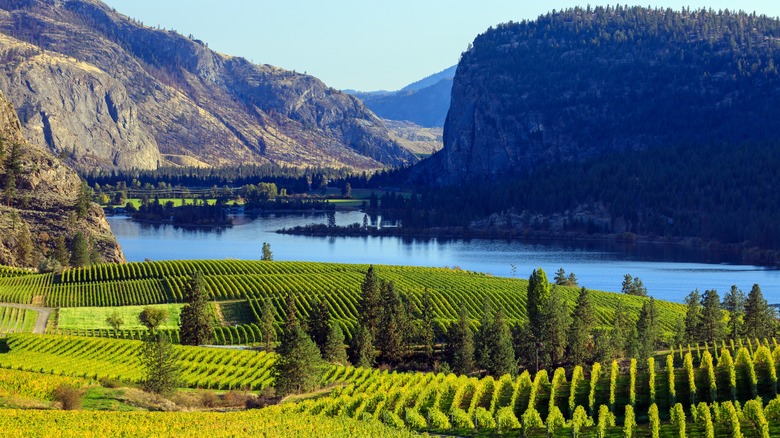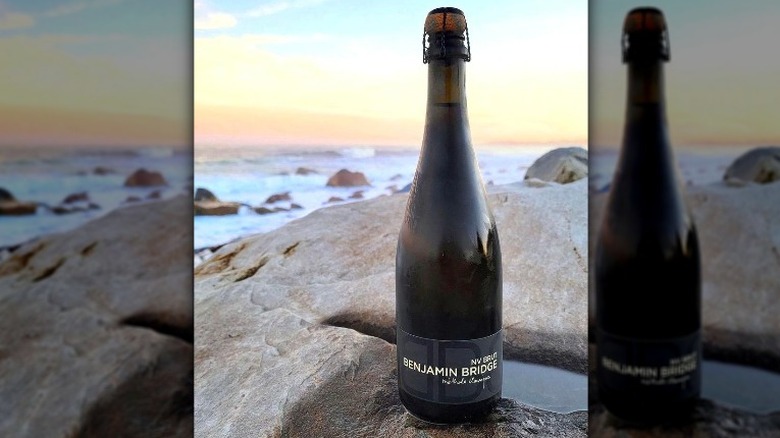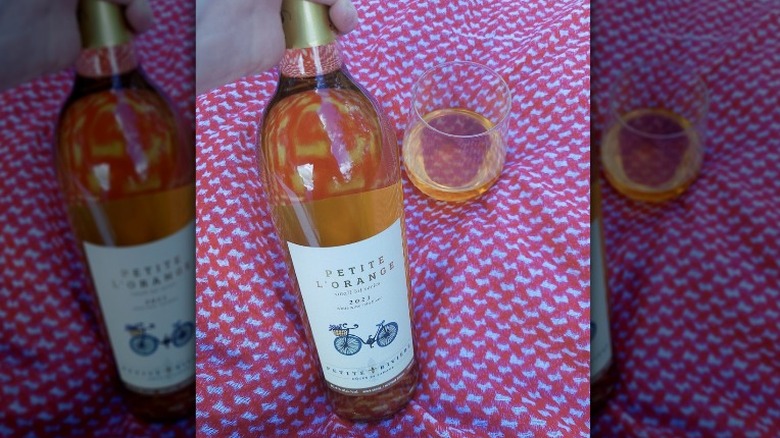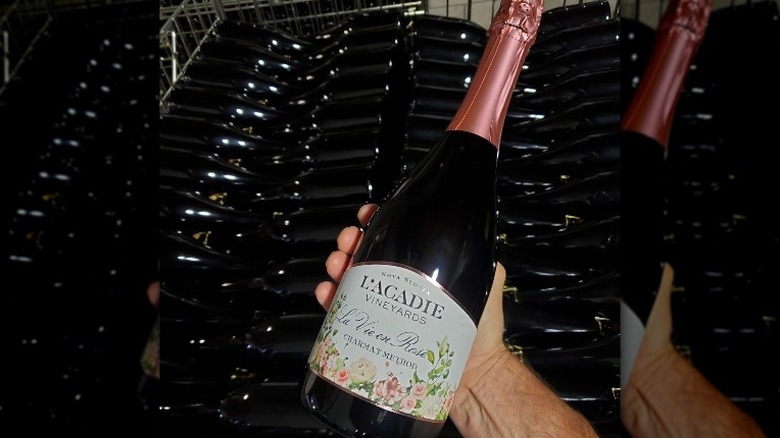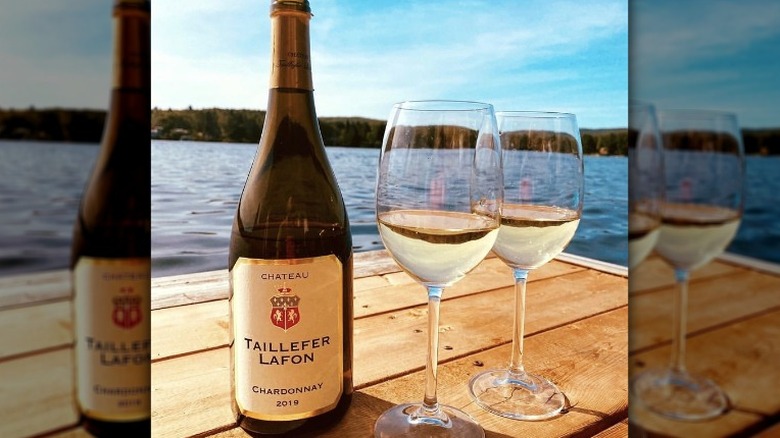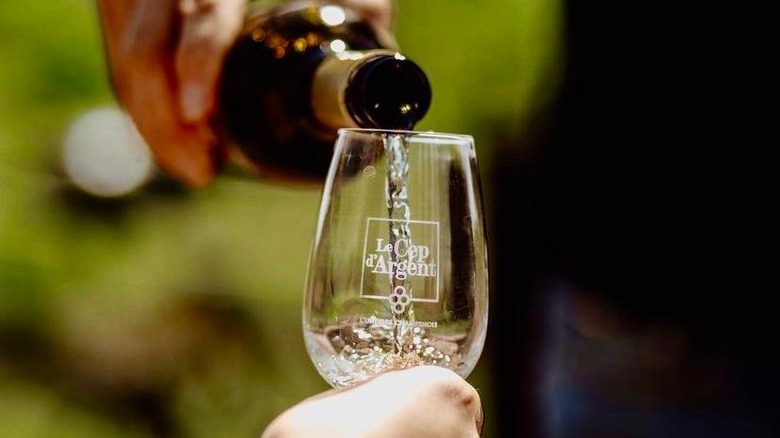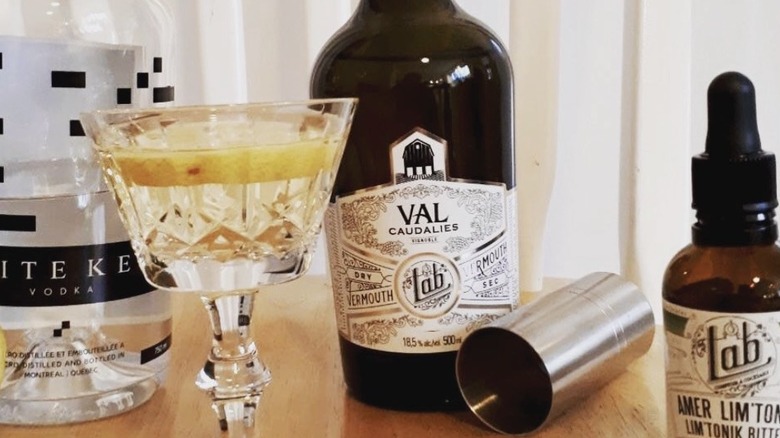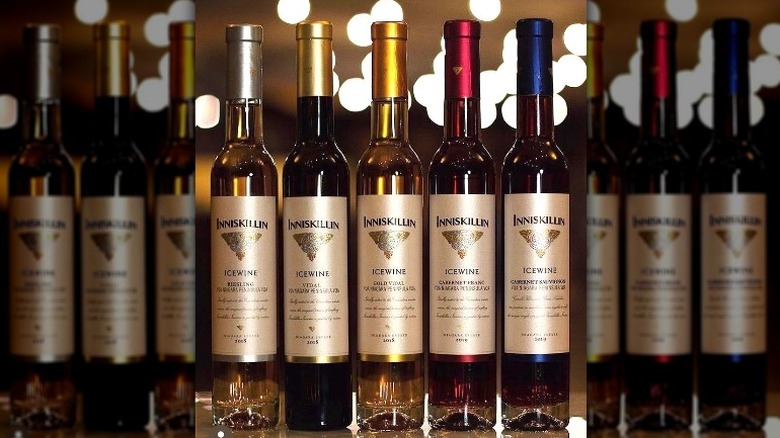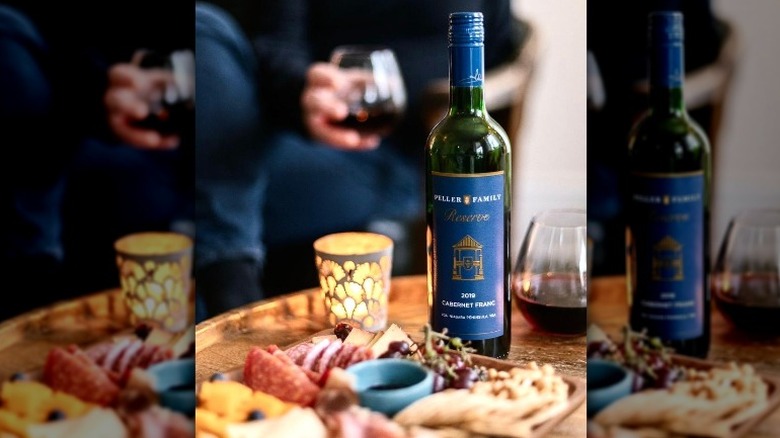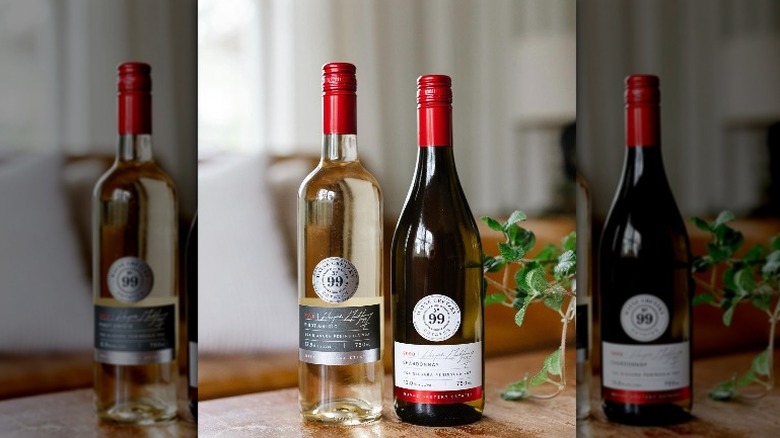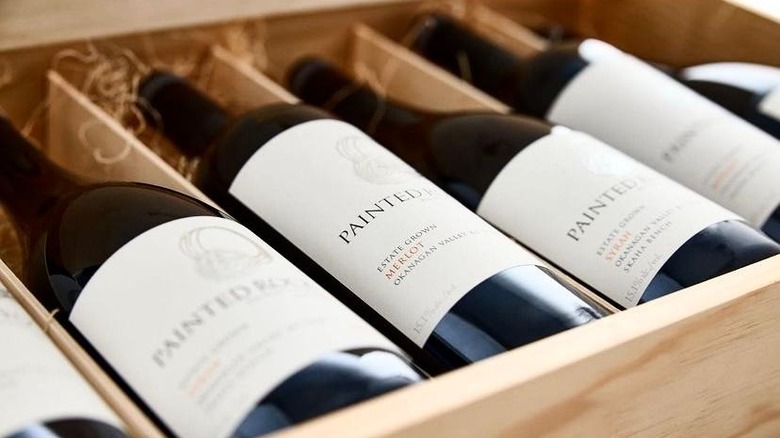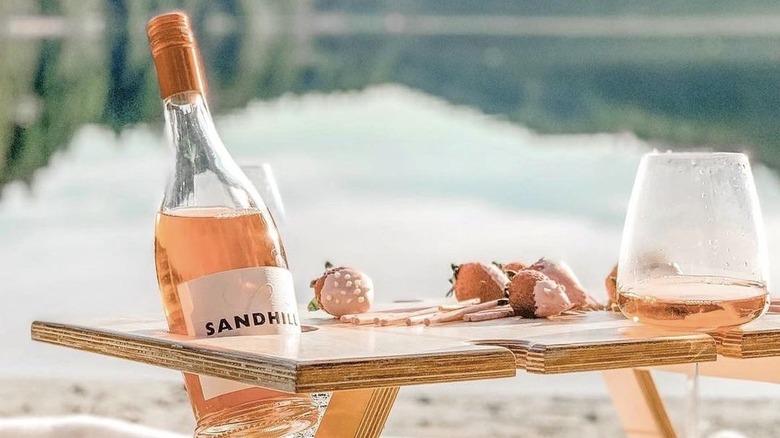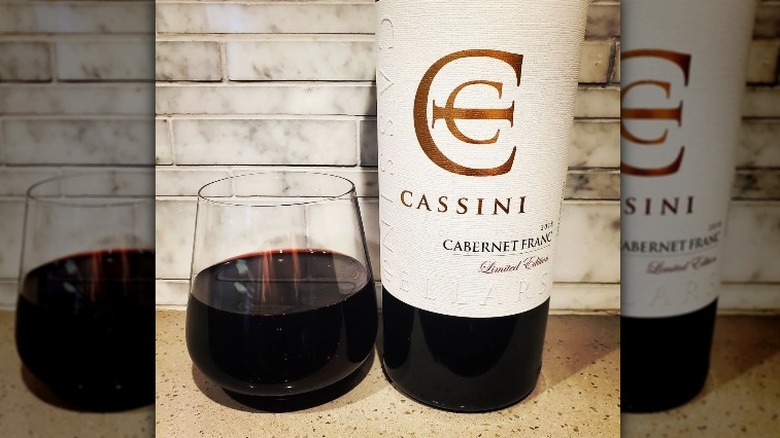Explore Canada With These 12 Wines
We may receive a commission on purchases made from links.
Canada isn't the first country people think of when it comes to wine, but it should. The southernmost regions of Canada fall in the latitude zone, per Jancis Robinson, best suited for growing grapes. Climate change is opening up wine production in emerging regions like Canada, per PNAS and Dr. Lee Hannah.
Viking Leif Erikson ventured onto North American shores in 1002. Finding lands teeming with wild grapevines, he named the region Vinland. Rod Phillips indicates that a German member of Erikson's crew may have crafted wine from the wild grapes, (via "The Wines of Canada"). Vins du Quebéc reports that Canadian founding father, Jacques Cartier, reported wild grape vines in 1535, and early French settler Samuel de Champlain planted vitis vinifera vines in Quebéc, pressing grapes for juice in 1603, notes "The Wines of Canada." Wines of Nova Scotia reports that Louis Hébert planted grapevines in Nova Scotia in 1611. More Nova Scotian settlers planted on the island in the 1630s, making them some of the oldest vineyards in North America, per the Toronto Sun. By the 1800s, vineyards were planted across Ontario and Quebéc, but prohibition destroyed Canada's budding wine industry. Wine growing perked up across the country in the 1970s and 1980s becoming the thriving business it is today, per "The Wines of Canada."
Benjamin Bridge 2014 Brut Reserve, Gaspereau Valley, Nova Scotia
The islands of Nova Scotia are just off the coast of Maine, New Brunswick, and Quebéc at the Gulf of St. Lawrence, per the Nova Scotia Wineries Tourism. In all, there are 58 wine-grape growers and 19 wineries in Nova Scotia. Of the seven wine regions in Nova Scotia, the Tidal Bay Appellation demonstrating style profile over terroir produces Nova Scotia's signature style — wines with racy acidity, bright aromatic notes, and relatively low alcohol. Salt Wire indicates that in 2022, there were 14 Tidal Bay wineries.
One of 12 wineries in Annapolis East, premier sparkling wine house Benjamin Bridge is located on the south-facing slopes of the Gaspereau Valley and is part of the Tidal Bay Appellation. Benjamin Bridge has been growing grapes organically for 20 years and produces exceptional sparkling wines. The Brut Reserve is an exquisite representation of sparkling wine, crafted from 70% chardonnay and 30% pinot noir, piquing interest from international crowds and influential wine media personalities like Natalie MacLean for its elegance, persistent fine mousse, and complex flavor profile.
Petite Rivière Vineyards Petite l'Orange, LaHave River Valley, Nova Scotia
Just southwest of Halifax in the Lunenburg region lies the LaHave River Valley and its idyllic wine region which flanks the southern shores of Nova Scotia. Dating back to the 1630s, its unique terroir consists of hilly vineyards planted in sandy, rocky soils based on slate and gravel. The Petite Rivière Vineyards are close to the ocean, and cooling breezes and foggy mornings temper the grapes, boosting their acidity and leading to quenching bold wines. Petite Rivière Vineyards began growing wine grapes in 1994 and opened its winery in 2004.
Petite Rivière Vineyards produces a range of wines from French-American hybrid and vitis vinifera grapes, alongside ciders and fruit wines. Known for its red wines, the winery also produces orange, rosé, white, fortified, and sparkling wines. Petite L'Orange is a blend of l'acadie, cayuga, and frontenac gris grapes with just enough skin contact during fermentation to give the wine a shimmering orange hue and lush notes of ripe apricot, blossoms, and crunchy green pears. Orange wines are perfect with delicately flavored seafood dishes and white meats or market salads and soft cheeses.
L'Acadie Vineyards Vintage Cuvée Rosé, Gaspereau Valley, Nova Scotia
In 2004, winemakers Bruce and Pauline Ewert left successful wine careers in the Okanagan Valley wine region (British Columbia) for Canada's eastern shores. Landing in the Gaspereau Valley of Nova Scotia, the pair founded L'Acadie Vineyards. Drawn by the mineral-rich schist and sandstone terroir built upon ancient seabeds, the Ewerts focused on organic farming, gaining the first organic certification for a vineyard in the province. Situated on northwest-oriented slopes near the sea, the grapes undertake slow ripening maintaining flavor phenolics and acidity perfect for mouthwatering wines. Their aim of producing traditional method sparkling wine came to fruition in 2008 after four years of experimentation. Masters of Wine reports that the traditional method, or the French method, is a labor-intensive process in which still wine is transformed into sparkling wine due to a secondary fermentation in its original bottle adding rich and creamy layers of flavor aromatics to the finished wine.
L'Acadie Vineyards' traditional method of sparkling wines went on to garner acclaim and awards in local, national, and international competitions. L'Acadie Vineyards Vintage Cuvée Rosé is a perfect example of a delicious, well-crafted sparkling wine. Produced with l'acadie, marechal foch, and seyval, the sparkling rosé spends nine months on the lees and 15 months aging before release resulting in ripe strawberry and cherry fruit aromas and flavors of brioche and shortbread on the palate. L'Acadie Vineyards also produces red wines, fortified wines, and cider.
Château Taillefer Lafon chardonnay, LavalQuebéc, Quebéc
Winemaking in Quebéc dates back to 1535, according to Vins Du Quebéc. Now, the province is home to approximately 150 wine producers and wineries, per "The World Atlas of Wine, Ed. 8." Quebéc wine growers focus on cold hardy and frost-resistant hybrid grape varietals with a warming climate paving the way for classic European vitis vinifera grapes. Since 1980, Quebéc has 800 hectares under vine in seven established wine regions and produces 2.5 million bottles of wine annually. That is an accomplishment in just a few decades. Culturally and linguistically French, Quebéc looks to its ancestral home France for enological inspiration. Working with French grape varietals alongside French-American hybrids, winemakers strive to produce a range of wine styles, per Vins du Québec.
Château Taillefer Lafon acquired its vineyard in 1976 and planted in 1999. By 2006, its wines were being sold to the public though its French-château inspired winery. Patterned after the opulence of King Louis XVI, Château Taillefer Lafon is a destination winery and vineyard with a dining room, weddings and event facilities, and business meeting spaces. Look for a range of red, white, rosé, fortified, and sparkling wines crafted from European vitis vinifera and French-American hybrid grapes. Try the chardonnay, produced like a French Meursault-style wine French aged in French oak barrels and on the lees, it is a buttery, rich, aromatic wine with baked apple and pear notes.
Le Cep d'Argent Selection Blanc de Blancs, Magog, Quebéc
Le Cep d'Argent is one of the first producers of traditional method sparkling wines in the province of Quebéc. Owned by François and Jean-Paul Scieur, the 114-acre property overlooks the picturesque Lake Magog on the Appalachian plateau and is studded with 60,000 vines of cold hardy French-American hybrid grapes. The Scieur brothers planned to produce sparkling wine from the beginning but also produce red, white, rosé, fortified, and icewines. Starting in 1993, the brothers invited the public to join in their harvest during their annual La Fête des Vendanges Magog-Orford celebration. Over the years the event has expanded to host 80,000 guests each year looking to explore the local wines, food, and bounty.
Known for its sparkling wines, Le Cep d'Argent Sélection Blanc de Blancs is expertly crafted from seyval blanc grapes. The wine is tart and tangy with notes of green apple, citrus, and a hint of pastry crème and freshly baked shortbread. Many types of sparkling wines are versatile and pair well with a variety of cuisines. Try one with Quebéc's signature dish; poutine, per National Geographic.
Val Caudalies Vignobles, Duham, Québec
High school friends Guillaume Leroux, Julien Vaillancourt, and Alexis Perron ventured into winemaking in 2005 when they founded Val Caudalies Vignobles in the Duham wine route region in Québec. Vins Du Quebéc indicates that the Val Caudalies Vignobles vineyards and orchards are located in a bucolic setting near Mount Pinnacle and the northern Appalachian mountain range just outside of Montréal. It is a perfect place for exploring the countryside with a hike or lounging over a picnic under the wooden ceiling of an open-air terrace.
The trio crafts wines, fruit-infused ciders, and vermouth from the fruit grown on the estate. The wine range includes red, white, orange, rosé, fortified, and late-harvest wines produced primarily from French-American hybrid grapes such as vidal and frontenac. The ciders are adventurous with a raspberry sparkling cider, an iced cider, and a sweet liqueur-style cider. Unique to Val Caudalies Vignobles is the vermouth project.
Sweet and dry vermouth are types of fortified wine infused with aromatic herbs, spices, and fruit, that are often used in cocktails as a flavoring, according to The Mixer. Vermouths have been produced in Europe for hundreds of years where they are consumed as apertives to stimulate the appetite and digestives to aid in digestion, per BK Wine Magazine. Val Caudalies Vignobles produces both a dry and sweet vermouth. Blend the sweet vermouth into a negroni or a manhattan and use the dry vermouth for the perfect martini.
Inniskillin Winery icewine, Niagara, Ontario
According to "The World Atlas of Wine, Ed. 8," Ontario is responsible for producing approximately half of Canada's wines. Home to more than 200 wineries situated along the southwestern shore of Lake Ontario, adjacent to western New York state, the region is famous for Niagara Falls. The Niagara Peninsula wine region is divided into 10 subregions with different microclimates and terroir. The latitude, at 43 degrees north, is well within the range for wine production, but Arctic airflow and storms can cause frigid temperatures stressing the vines. Lake Ontario protects the wine region from the devastation in the winter and moderates temperatures in the summer, extending the growing season. Known for its honeyed and fragrant ice wines (via Wines of Canada), the region produces a range of wines from European vitis vinifera and French-American hybrid grapes, notes Wine Country Ontario.
Canada's oldest wine estate, Inniskillin, has vineyards in Niagara and in the Okanagan Valley (British Columbia). Donald Ziraldo planted riesling, chardonnay, and gamay vitis vinifera grapes in Niagara in 1974 and harvested his first crop in 1977. In 1984, the first vintage of ice wine was produced from frozen vidal grapes and soon became "one of the greatest wines in the world." With its delicate honeyed and floral notes, Inniskillin ice wine is a treat not to be missed. Look for vidal, riesling, cabernet franc, and sparkling ice wines. The estate also makes a range of table red, white, rosé, and dessert wines.
Peller Estates Winery Signature Series cabernet franc, Niagara, Ontario
Peller Estates Winery, owned by the family of the late Andrew Peller, is an immigrant success story. Landing in Nova Scotia from Hungary in 1927, Andrew Peller ventured west to British Columbia. The visionary founded his first vineyard five years later in the heart of the Okanagan Valley. Hoping to influence Canada with his love of European wine culture, Pellar eventually founded vineyards in Nova Scotia and Ontario. The family opened Andrew Pellar Limited to support small and emerging brands in need of support from a larger, established brand. Currently, they have 15 additional wine brands under their umbrella.
The palatial Peller Estates Winery in Niagara is now the flagship offering tastings, tours, fine dining, and meeting spaces for romantic and business events. Its wine range includes red, rosé, white, sparkling, and ice wines, crafted from a variety of European vitis vinifera and French-American hybrid grapes including cabernet sauvignon, merlot, pinot noir, and baco noir. Peller Estates Signature Series cabernet franc is exceptional. A French grape from the famed Loire Valley and often used as a blending grape in Bordeaux (via Wine Folly), cabernet franc is a parent to its famous offspring: cabernet sauvignon, merlot, and carménère. It is rich and inky with ample dark berry, currant, and plum notes along with cypress, and graphite giving way to silky tannins and a firm structure. Delish.
Wayne Gretzky Estates Whisky Oak Aged Red, Niagara, Ontario
Wayne Gretzky – yes, that Wayne Gretzky, gained his love for wine as a child at the feet of his winemaking grandfather. Often, celebrity wine brands are simply vanity projects, but once in a while, the celebrity behind the brand is involved every step of the way. That is Wayne Gretzky. One would expect nothing less from "The Great One No.99," arguably the greatest hockey player Canada has produced, via NHL.com. It is only natural that he would strive for excellence in the wines he produces under his name.
With vineyard properties in Niagara and Okanagan Valley, British Columbia, Wayne Gretzky Estates has access to the best Canadian fruit. Gretzky produces an acclaimed range of table and ice wines. Aiming to appeal to everyone, just like Gretzky did on the ice, Wayne Gretzky Estates has its own brewery and whisky distillery alongside fine dining and meeting space options at its 23,000-square-foot facility. His No.99 whisky, aged in casks, provides the barrels for his whisky cask-aged red wine, No.99 Whisky Oak Aged Red. A blend of cabernet sauvignon, cabernet franc, and merlot, the wine spends time in French and American oak as it matures and finishes in aromatically flavored whisky barrels to "give it punch and power" while imparting tobacco and spice notes to the plummy, black cherry, and vanilla fragranced wine.
Painted Rock Estate Winery syrah, Okanagan Valley, British Columbia
British Columbia is one of the most promising emerging wine regions in the world. Since its foundation in the 1990s with just a handful of wineries, the wine business has grown to boast nearly 300 wineries and roughly 10,000 acres under vine across nine official wine regions, according to "The World Atlas of Wine, Ed. 8." Wines of British Columbia reports that British Columbia experiments with French-American hybrid grapes and European vitis vinifera. Wines of Canada indicates that British Columbia's nine DVAs (designated viticultural areas) lie at the southern sector of the province between 40 and 51 degrees latitude, and stretch from the Gulf and Vancouver Island in the west to Kootenays in the east. Okanagan Valley is the largest and most prolific region, per "The World Atlas of Wine, Ed.8."
The acclaimed Painted Rock Estate Winery exemplifies great award-winning British Columbian wines. Its aim from the beginning was to produce ultra-premium wines from European vitis vinifera grape varietals. Nestled in the Okanagan Valley, the Painted Rock vineyards are considered to be amongst the best in the entire region. The winery produces a range of wines, but its bold and spicy syrah is unique. The varietal is uncommon in Canada and Painted Rock Winery Syrah is an expression is reminiscent of the French Northern Rhône style with its distinctly floral, bramble, and peppery aromatics.
Sandhill Winery sangiovese rosé, Okanagan Valley, British Columbia
Sandhill Winery in the Okanagan Valley is focused on terroir as the primary foundation in crafting its single vineyard estate wines. Sandhill believes in a low-intervention approach to its winemaking and stresses that wines are made in the vineyard; or one of six vineyards in its viticultural portfolio. Each parcel is unique in its microclimate affording Sandhill some of the best fruit in the valley.
Deciding against the classic vineyard winery tasting room, Sandhill opened an urban tasting room adjacent to Calona winery (via Sandhill Winery website) in Kelowna for a unique, yet on-trend winery sipping and supping experience, per Eat Magazine. Sandhill winery produces white, red, rosé, and ice wines from its specific estate vineyards. Look for its rosé crafted from the Italian signature grape, sangiovese with its lush and fruity Morello cherry, wild strawberry, and zesty citrus notes. Sandhill Sangiovese rosé is a food-friendly wine perfect for sipping all year round.
Cassini Cellars pinot noir, Oliver, Okanagan Valley, British Columbia
Cassini Cellars is located on what is dubbed the Golden Mile Bench, a subregion of the Okanagan Valley, per Wines of British Columbia, considered to be some of the best vineyard lands in the entire country. The Golden Mile Bench is slightly cooler, with a unique terroir and microclimate and a western-slope exposure perfect for cool-climate grapes. Passionate about wine and dedicated to perfection, Cassini Cellars strives to produce elegant and European-influenced wines that are distinctly Canadian. Year in Wine reports that Cassini Cellars founder, Adrian Cassini, a Romanian-born generational winemaker, first immigrated to Montreal in 1990, but made his way to Vancouver soon after. Along with his wife, he purchased a lavender farm in the Okanagan Valley in 1996 and set his sights on making wine. His first vintages were crafted from purchased grapes, but soon Cassini acquired access to vineyard lands in Oliver.
Cassini Cellars consistently produces award-winning, small-batch wines. The range includes red and white wines from cabernet sauvignon, cabernet franc, malbec, merlot, chardonnay, and muscat. Look for Cassini Cellars pinot noir for a unique Canadian wine experience. The pinot noir exudes classic notes of ripe cherry, tangy raspberry, spice, and an earthiness specific to pinot noir. Pair it with game birds, wood-fired pizza, grilled salmon, and roasted vegetables. Or, simply savor it on its own.
